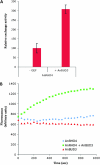Regulation of septum formation by the Bud3-Rho4 GTPase module in Aspergillus nidulans
- PMID: 20176976
- PMCID: PMC2870952
- DOI: 10.1534/genetics.110.114165
Regulation of septum formation by the Bud3-Rho4 GTPase module in Aspergillus nidulans
Abstract
The ability of fungi to generate polarized cells with a variety of shapes likely reflects precise temporal and spatial control over the formation of polarity axes. The bud site selection system of Saccharomyces cerevisiae represents the best-understood example of such a morphogenetic regulatory system. However, the extent to which this system is conserved in the highly polarized filamentous fungi remains unknown. Here, we describe the functional characterization and localization of the Aspergillus nidulans homolog of the axial bud site marker Bud3. Our results show that AnBud3 is not required for polarized hyphal growth per se, but is involved in septum formation. In particular, our genetic and biochemical evidence implicates AnBud3 as a guanine nucleotide exchange factor for the GTPase Rho4. Additional results suggest that the AnBud3-Rho4 module acts downstream of the septation initiation network to mediate recruitment of the formin SepA to the site of contractile actin ring assembly. Our observations provide new insight into the signaling pathways that regulate septum formation in filamentous fungi.
Figures









Similar articles
-
Morphogenetic and developmental functions of the Aspergillus nidulans homologues of the yeast bud site selection proteins Bud4 and Axl2.Mol Microbiol. 2012 Jul;85(2):252-70. doi: 10.1111/j.1365-2958.2012.08108.x. Epub 2012 Jun 19. Mol Microbiol. 2012. PMID: 22651396
-
Functional characterization and localization of the Aspergillus nidulans formin SEPA.Mol Biol Cell. 2002 Feb;13(2):469-79. doi: 10.1091/mbc.01-07-0356. Mol Biol Cell. 2002. PMID: 11854405 Free PMC article.
-
Isolation of mutations that bypass the requirement of the septation initiation network for septum formation and conidiation in Aspergillus nidulans.Genetics. 2006 Jun;173(2):685-96. doi: 10.1534/genetics.105.054304. Epub 2006 Apr 19. Genetics. 2006. PMID: 16624915 Free PMC article.
-
Polarity in filamentous fungi: establishment, maintenance and new axes.Curr Opin Microbiol. 2002 Dec;5(6):580-5. doi: 10.1016/s1369-5274(02)00368-5. Curr Opin Microbiol. 2002. PMID: 12457701 Review.
-
Functional diversity of chitin synthases of Aspergillus nidulans in hyphal growth, conidiophore development and septum formation.Med Mycol. 2009;47 Suppl 1:S47-52. doi: 10.1080/13693780802213332. Epub 2008 Jul 14. Med Mycol. 2009. PMID: 18651309 Review.
Cited by
-
Actin organization and dynamics in filamentous fungi.Nat Rev Microbiol. 2011 Nov 2;9(12):876-87. doi: 10.1038/nrmicro2666. Nat Rev Microbiol. 2011. PMID: 22048737 Review.
-
Protein kinases MpkA and SepH transduce crosstalk between CWI and SIN pathways to activate protective hyphal septation under echinocandin cell wall stress.mSphere. 2025 Jan 28;10(1):e0064124. doi: 10.1128/msphere.00641-24. Epub 2024 Dec 13. mSphere. 2025. PMID: 39670729 Free PMC article.
-
Altered secretion patterns and cell wall organization caused by loss of PodB function in the filamentous fungus Aspergillus nidulans.Sci Rep. 2018 Jul 30;8(1):11433. doi: 10.1038/s41598-018-29615-z. Sci Rep. 2018. PMID: 30061727 Free PMC article.
-
Identification of an amphipathic helix important for the formation of ectopic septin spirals and axial budding in yeast axial landmark protein Bud3p.PLoS One. 2011 Mar 8;6(3):e16744. doi: 10.1371/journal.pone.0016744. PLoS One. 2011. PMID: 21408200 Free PMC article.
-
Lah is a transmembrane protein and requires Spa10 for stable positioning of Woronin bodies at the septal pore of Aspergillus fumigatus.Sci Rep. 2017 Mar 10;7:44179. doi: 10.1038/srep44179. Sci Rep. 2017. PMID: 28281662 Free PMC article.
References
-
- Abe, K., K. L. Rossman, B. Liu, K. D. Ritola, D. Chiang et al., 2000. Vav2 is an activator of Cdc42, Rac1, and RhoA. J. Biol. Chem. 275 10141–10149. - PubMed
-
- Balasubramanian, M. K., E. Bi and M. Glotzer, 2004. Comparative analysis of cytokinesis in budding yeast, fission yeast and animal cells. Curr. Biol. 14 R806–R818. - PubMed
-
- Bruno, K. S., J. L. Morrell, J. E. Hamer and C. J. Staiger, 2001. SEPH, a Cdc7p orthologue from Aspergillus nidulans, functions upstream of actin ring formation during cytokinesis. Mol. Microbiol. 42 3–12. - PubMed
Publication types
MeSH terms
Substances
LinkOut - more resources
Full Text Sources
Molecular Biology Databases

